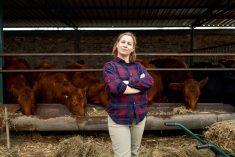Health Canada’s Veterinary Drug Directorate has approved a number of different products that improve the growth performance and feed efficiency of feedlot cattle. There is some confusion about how some of the newer growth promotants work. Here’s a quick summary of some of the growth promotants the feedlot sector uses.
Ionophores alter how the feed is digested, and improve nutrient availability to the animal. These antimicrobials are not used in human medicine, but they can improve feed efficiency and weight gain in cattle (among other things). Ionophores improve feed effi- ciency by acting on the rumen microbes. Most rumen microbes convert the complex fibre and starch in forage and grain into simple molecules that can be absorbed into the bloodstream to provide energy and protein to the animal. Some rumen bacteria (known as methanogens) convert the dietary fibre and starch into methane gas. Methane contains energy, but it cannot be absorbed by the animal, so it is belched out and wasted. Ionophores improve feed efficiency and weight gain by selectively inhibiting methanogenic bacteria, and allow the beneficial rumen bacteria to make more feed energy available to the animal.
Read Also

A strategic approach to risk on the ranch
Given the increase in the value of livestock and the market volatility, we need to cover our risks. First,…
Other growth promotants impact how nutrients are used by the animal after the nutrients have been absorbed into the bloodstream.
Growth implants enhance the reproductive hormones that occur naturally in the animal. In steers, implants replace some of the hormones that were removed when the animal was castrated. Implants generally encourage protein deposition and discourage fat deposition. This improves both weight gain and feed conversion. Fat deposition requires more than twice as much feed energy as protein deposition does. In addition to this, muscle tissue contains around 70 per cent water, while fat contains less than 25 per cent water. This means that for every 10 pounds of muscle gained, about three pounds comes from dry feed and seven pounds comes from water. This ratio is reversed for fat growth (roughly seven pounds from dry feed and three pounds from water). Aggressive implant regimes may negatively impact carcass quality (maturity, marbling score, tenderness, and possibly lean colour).
Beta adrenergic agonists are the newest class of growth promotants. These feed additives are not antimicrobials, and do not mimic or supplement reproductive hormones. “Beta adrenergic agonist” is a complicated name that describes what these products do. Adrenergic means “resembling adrenaline.” Agonist (the opposite of antagonist) means that “it works in a similar manner.” The beta refers to the particular receptor that it binds to on the muscle cell surface. So a beta adrenergic agonist is a substance that binds to a beta receptor on the muscle, and acts sort of like adrenalin. Adrenalin diverts blood flow from the digestive organs towards the muscle during the “fight or flight” response. Similarly, beta agonists encourage nutrient repartitioning from the internal organs to the muscle. All beta agonists approved for beef cattle increase protein deposition (muscle growth), growth rate, feed efficiency, and carcass leanness. Some beta agonists also reduce protein turnover (reduce muscle breakdown), resulting in increased dressing percentage. Beta agonists are fed at the end of the feeding period, when muscle growth is slowing, fat deposition is speeding up, and feed efficiency is dropping off. As with aggressive implants, beta agonists must be managed appropriately, on the right class of cattle in order to avoid negative consequences on carcass quality. The benefit of feeding beta agonists can be lost if the product is fed for too long, or if the delay between product withdrawal and slaughter is too long.
Growth promotants are valuable tools for the cattle feeding sector. In a study published in theJournal of Animal Science,Dr. Ira Mandell (University of Guelph), Robert Berthiaume (AAFC Lennoxville Research Station) and Carole Lafrenire (AAFC Kapuskasing) reported that overall average daily gain was 21 per cent higher and feed efficiency was 23 per cent better for grain-finished cattle given both implants and ionophores compared to control cattle. Economists John Lawrence and Maro Ibarburu at Iowa State University reported that feedlot average daily gain increased when ionophores (3% increase), implants (16%), and betaagonists (16%) were used. Feed efficiency improved when ionophores (4% better), implants (10%) and beta-agonists (14%) were used. Their analysis indicated that feedlot production costs would be 10 per cent higher if producers chose not to (or were unable to) use implants, ionophores or beta agonists.
As with all refined technology, appropriate and optimal use of these products can improve animal performance and value, while improper use results in no benefit, reduced carcass value, and/or lost money. Feedlots, nutritionists and veterinary experts base their decisions to use these products on past experience, the type of cattle being fed, marketing practices and packer specifications.
ReynoldBergenistheScienceDirectorfortheBeefCattle ResearchCouncil.AportionoftheNationalcheckoffis directedtotheBCRCtofundresearchanddevelopment activitiestoimprovethecompetitivenessandsustainabilityof Canada’sbeefindustry.
















